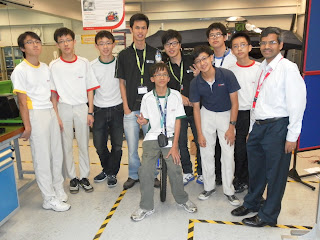1. Discuss how the project has helped to deepen your understanding/ broaden your awareness on the selected discipline.
2. Describe how the new learning can be connected to what you learnt/ are going to learn.
Tuesday, June 7, 2011
Our Accomplishment
The TEAM interacting with NTU leaders.


The TEAM hard at work




Our Product
The bicycle is mount onto a structure and its tyre must be connected to the dynamo. The bicycle is pedaled to turn and maintain the speed of 2700 to 3100rpm, reaching a voltage of 13 to 15V to charge the 12V car battery. A diode is used in the circuit to prevent the back flow of the current.


The TEAM hard at work




Our Product
The bicycle is mount onto a structure and its tyre must be connected to the dynamo. The bicycle is pedaled to turn and maintain the speed of 2700 to 3100rpm, reaching a voltage of 13 to 15V to charge the 12V car battery. A diode is used in the circuit to prevent the back flow of the current.
Introduction: Applied Challenge Project
Project Title
Battery Charging from Bi-cycle Pedal Power
Introduction
This project is started when a group of young innovators travelled for a humanitarian work in a small undeveloped village in Baray, Cambodia.The group realised that the villagers is denied of accessing clean water and electricity is expensive, thus they decided to design and create a device which can be used to charge a battery which can be used by the village.

The group made some observations and realised that the villagers are high in stamina and they are very fit as they walk to travel from places to places.Taking considerations of their observations, the group decided to make use of a bicycle to turn a dynamo to charge a 12V battery.
In this challenge, the pupils will learn about the working principles of a dynamo, battery charging/discharging procedures and electrical elements required for the project.
Battery Charging from Bi-cycle Pedal Power
Introduction
This project is started when a group of young innovators travelled for a humanitarian work in a small undeveloped village in Baray, Cambodia.The group realised that the villagers is denied of accessing clean water and electricity is expensive, thus they decided to design and create a device which can be used to charge a battery which can be used by the village.

The group made some observations and realised that the villagers are high in stamina and they are very fit as they walk to travel from places to places.Taking considerations of their observations, the group decided to make use of a bicycle to turn a dynamo to charge a 12V battery.
In this challenge, the pupils will learn about the working principles of a dynamo, battery charging/discharging procedures and electrical elements required for the project.
Subscribe to:
Comments (Atom)

